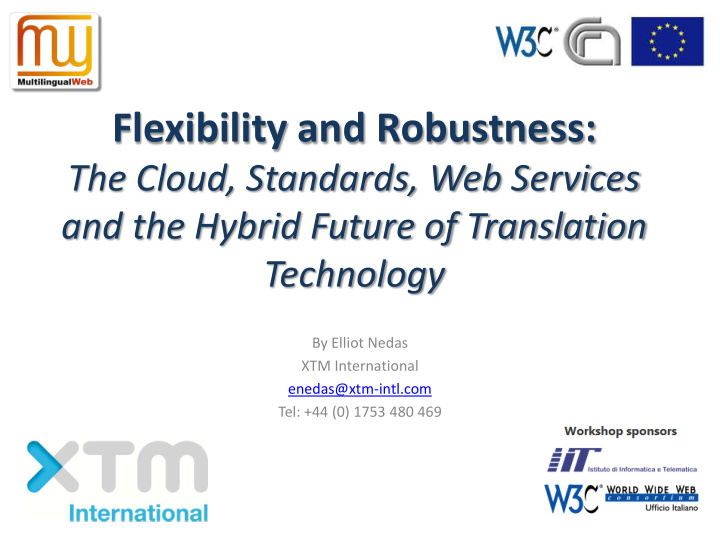



Flexibility and Robustness: The Cloud, Standards, Web Services and the Hybrid Future of Translation Technology By Elliot Nedas XTM International enedas@xtm-intl.com Tel: +44 (0) 1753 480 469
The Content Cycle
Interdependence Drives the need for standardisation To make information sharing less problematic Need to improve internal and external lines of communication…
The Demise of LISA Indicative of the dated model used for standards development in the Localization Industry. Modern markets demand new ideas Opportunity for new models of Standard dissemination
The New Kids on The Block Leading with example.. Carrying the Standards Engaging new torch post the end of stakeholders and LISA… making Standards We must see how they approach the dissemination of Standards fashionable… solutions . http://interoperabilit y-now.org/tiki
Standards. • W3C ITS Document Rules • Unicode TR29 • LISA OSCAR SRX • LISA OSCAR xml:tm • LISA OSCAR TMX – Apparently dead…! • LISA OSCAR GMX • OASIS XLIFF • W3C/OASIS DITA, XHTML, DocBook, or any component based XML Vocabulary
The Current Situation…
What is missing? A Standard Solution…. Standards provide a guide for general use, but there is no SOLUTION (only component solutions) which can be easily described. An example of a SOLUTION…
Example Solution…NOT Standar Clay Tablet is not a Standard, but it does provide a solution which STANDARDIZES inter systems communication.
OAXAL A Standards Based Solution: OAXAL Unicode TR29 W3C ITS XLIFF GMX TMX S RX Author Memory Translation Memory xml:tm XML Vocabulary, e.g. DITA XML1.0 Unicode 5.0
Comparison… Clay Tablet = Simplification – The Solution is described simply. OAXAL = Complication – The Solution is there, but it is diffuse and requires deep technical knowledge to implement… However there are many benefits to OAXAL…
OAXAL in Action • Free for use! (Apart from human capital costs) • Totally web based • Use Industry Standards • Real time sharing of Translation Memory and Terminology • Allows for Collaborative translation • Integration with MT • Web services and Open APIs
OAXAL as a product: A modern Standards based approach to translation technology
Why is web based the future?
In the future we think all translation tools will…. • Be totally intuitive hybrid systems. • Actually use Standards. • Integrate social media type tools for communication • Use advanced TM architectures for total control of linguistic assets. • Powerful Quality Controls, including automated and human review features. • Enable Real-Time previews of all content types • Advanced MT of all types. • Have user configurable automation. • Allow for Easy integration with content cycles. • Work from any platform.
Winners and Losers… Ever person involved in translation can benefit from the use of Standards. The Winners will be forward thinking groups that get the message across to the key stakeholders. • Senior Management • Developers • Users
How to Spread The Message… Make being non-Standard unattractive to developers. Approach the tools developers (the actual coders) to implement accurate renditions of the standards. Tell senior managers that they will SAVE money and time once they implement Standards. And please engage the tool developers…!
The need to communicate! End Client LSP Dev S-User
Keep at it and present SOLUTIONS! Elliot Nedas enedas@xtm-intl.com Phone: +44 1753 480 4690
Recommend
More recommend